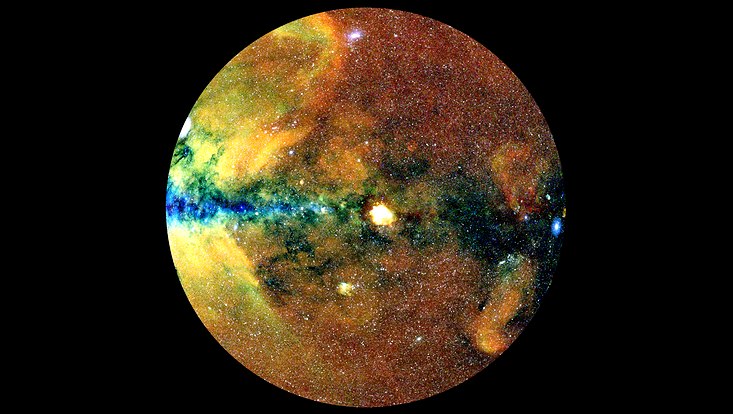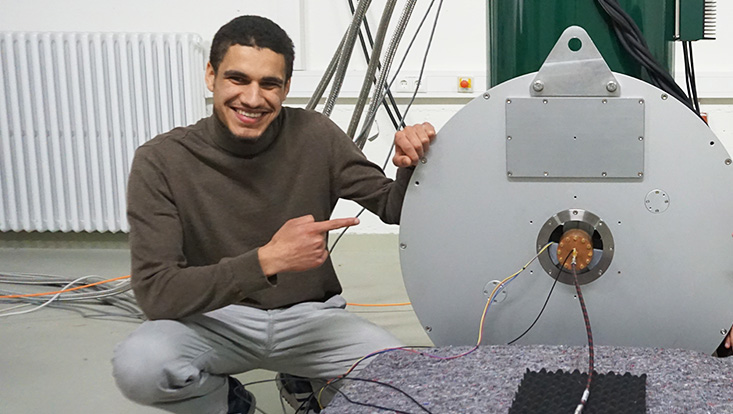The X-ray sky opens to the world
31 January 2024

Photo: MPE, J. Sanders for the eROSITA consortium
The German eROSITA consortium, which includes researchers from Universität Hamburg, today published the data from its part in the first all-sky survey with the eROSITA soft X-ray imaging telescope on board the Spectrum-RG satellite. The first eROSITA all-sky survey catalog (eRASS1) is the largest X-ray catalog ever published with around 900,000 different sources.
Along with the data, the consortium released today a series of scientific papers describing new results ranging from studies of the habitability of planets to the discovery of the largest cosmic structures. Based on just the first six months of observations, eROSITA has already detected 60% more sources than had previously been known in the 60-year history of X-ray astronomy. Now available to the worldwide science community, the data will revolutionise our knowledge of the Universe at high energies. The University of Hamburg plays an important role in this consortium, being responsible for the mission planning as well as conducting research on stars and galaxy clusters.
The observations with the eROSITA telescope were carried out from 12 December 2019 to 11 June 2020. The first eROSITA catalogue (eRASS1) covers half the sky, the data share of the German eROSITA consortium. It consists of more than 900 000 sources, ranging from some 710 000 supermassive black holes in distant galaxies to 180 000 X-ray emitting stars in our own Milky Way, 12 000 clusters of galaxies, plus a small number of other exotic classes of sources, such as binary stars, supernova remnants, pulsars, and other objects.
“These are mind-blowing numbers for X-ray astronomy,” says Andrea Merloni, eROSITA principal investigator and first author of the eROSITA catalogue paper. “Even the first data release will revolutionise our view of extreme objects in the universe.“, says Marcus Brüggen, Professor for Astrophysics at the University of Hamburg and a member of the eROSITA steering board.
Co-ordinated with the release, the German eROSITA Consortium has submitted almost 50 new scientific publications to peer-reviewed journals, adding to the more than 200 which have already been published by the team before the data release. Most of the new papers appeared today (see link below) and present numerous new discoveries; including a statistical analysis of flickering supermassive black holes over cosmological distances and the discovery of a warm-hot filament of pristine gas between clusters of galaxies, the discovery of two new ‘Quasi-Periodically Erupting’ black holes, and two studies of how X-ray irradiation from a star may affect the atmosphere and water redemption of orbiting planets.
In one of the publications that were released alongside with the data, a team involving scientists from Hamburg were able to identify roughly 140 000 stars that shine in X-rays, by far the largest sample so far. “The X-ray radiation comes from the hot corona around the stars and affects the environment of the stars and potentially even orbiting planets as well as things that happen on the surface of those planets.”, explains Dr. Jan Robrade from Hamburg Observatory, UHH, a key author of this study.
This first eRASS data release makes public not only the source catalogue, but images of the X-ray sky at multiple X-ray energies. “There is more data to come. This is only the result from six months’ worth of scanning the sky. More data is going to be made public in the future”, explain Prof. Brüggen.
The activities in Hamburg are supported by funding from the Deutsches Zentrum für Luft- und Raumfahrt (DLR) as well as the Cluster of Excellence Quantum Universe.
For the university's press release on eROSITA in German, visit here.
Original Publications
Merloni A., et al. The SRG/eROSITA all-sky survey, First X-ray catalogues and data release of the Western Galactic hemisphere Astronomy & Astrophysics, volume 682, A34 https://www.aanda.org/10.1051/0004-6361/202347165
Freund et al., The SRG/eROSITA all-sky survey -Identifying the coronal content with HamStar, A&A https://arxiv.org/abs/2401.17282


